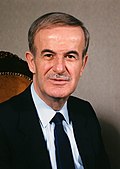| |||||||||||||||||||||||||
All 250 seats in the Parliament of Syria 126 seats needed for a majority | |||||||||||||||||||||||||
|---|---|---|---|---|---|---|---|---|---|---|---|---|---|---|---|---|---|---|---|---|---|---|---|---|---|
| Registered | 6,037,885 | ||||||||||||||||||||||||
| Turnout | 61.17% ( | ||||||||||||||||||||||||
| |||||||||||||||||||||||||
| |||||||||||||||||||||||||
 |
|---|
|
Parliamentary elections were held in Syria on 24 and 25 August 1994. [1] Members were elected using the multiple non-transferable vote in fifteen districts, with an average district magnitude of 16.7. [2] The result was a victory for the Ba'ath Party, which won 135 of the 250 seats. [3] Voter turnout was 61.2%.

